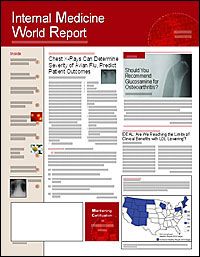Publication
Article
Internal Medicine World Report
New, Virulent C Difficile Strain Strikes Typical and Atypical Patients
Author(s):
Mounting evidence of a novel, highly virulent strain of Clostridium difficile is underscoring the tenacity of certain patho?gens to face new threats by transmogrifying into more monstrous versions of ?themselves.
A study published in the New England Journal of Medicine (2005;353:2442-2449) identified 1719 episodes of nosocomial C difficile?associated diarrhea in 1703 patients who were admitted to 12 hospitals in Quebec, Canada, in 2004. Investigators found an incidence that was 4 times higher than just 7 years earlier?22.5 for every 1000 admissions in 2004 versus 6 for every 1000 admissions in 1997.
Both incidence and mortality rates attributable to the C difficile?associated diarrhea increased with age (Table).
A random sample of 237 of these patients was matched with 237 control patients (who had no history of C difficile? associated diarrhea).
Compared with the controls, case patients were more likely to have received antibiotic therapy (79.3% vs 59.3%; P <.001) and to have had enteral feeding (18.6% vs 11.8%; P = .04). Exposure to ce?ph?alosporins and to fluoroquin?olones were found to be significant independent risk factors for C difficile?assoc?iated diarrhea.
Analysis of 157 representative C difficile isolates revealed that the responsible strain had binary toxin and a partial deletion of the tcdC gene. A second study in the same issue of the New England Journal of Medicine (pages 2433-2441) reported that this previously uncommon C difficile strain has demonstrated growing resistance to all fluoroquinolone antibiotics and has been identified as a cause of C difficile?associated disease outbreaks in such geographically diverse areas as Georgia, Illinois, Maine, New Jersey, and Oregon.
In an accompanying editorial (pages 2503-2505), John G. Bartlett, MD, and Trish M. Perl, MD, both of Johns Hopkins University School of Med?icine, Baltimore, Md, suggested some pre??ven?tive measures:
? Fastidious use of barrier precautions
? Patient isolation
? Environmental cleaning with sporicidal agents active against C difficile
? Fastidious use of hand hygiene.
They recommended that physicians monitor for an increasing incidence of C difficile?associated disease based on classic features, ie, antibiotic therapy complicated by diarrhea, fever, leukocytosis (sometimes with leukemoid reaction), and hypo?albuminemia and/or toxic megacolon. Although standard stool assays will not usually identify this epidemic strain, it may be suspected based on the number and severity of cases.






